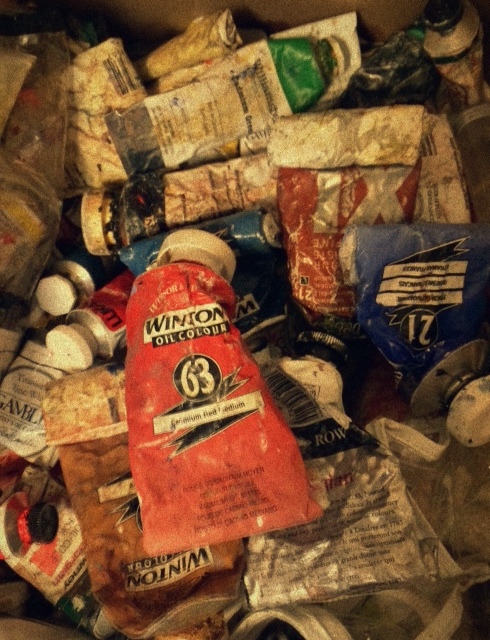Workshop materials:oil

Below you will find materials lists for most classes. You should be able to cut and paste it to your fav word program...
Plein air and studio: Oil
I prefer a limited palette (oil) of warm and cool of each primary color plus white:
Cadmium Lemon, Cadmium Yellow Med and/or Yellow Ochre, Cadmium Red Lt or Permanent Red, Alizarin Crimson, Ultramarine Blue. Prussian Blue and or Viridian, Titanium White unless you prefer flake or zinc white, Burnt Sienna, Black (optional)
Tube Grays ( optional but a few tubes of warm and cool values go a long way)
If you have favorite pigments, bring em. There is no one perfect palette. Though I have a thing against tube greens… but you can bring those too.
A good starter palette is a warm and a cool of yellow red and blue, but if you want to augment this with, say, Kings Blue or Viridian or Rose Madder or Cad Orange, be my guest.
Oils: Utrecht, Gamblin, Gamblin 1980 are best paints for the money. Daylor-Rowney Greorgian is okay enough for experimenting, affordable and comes in big tubes; Winton/Windsor Newton,Rembrandt, Grumbacher are also fine. Count on using a lot of paint.
Thinner: Turpenoid or Gamsol or Mona Lisa, you can go thinner free and just use Artists medium or linseed oil.
Can or container to hold turpenoid or medium
Easel – For painting outside, I recommend a good portable and multifunctional easel that you can get from OpenBoxM or EasyL through www.artworkessentials.com, www.Stradaeasel.com, Tell them I sent you. I have several of each and use different ones for different reasons. Key consideration is what size canvas will it hold and how big do you like to work.
Tri-pod for Box type easels, get whatever is recommended for the easel you have. Don't go to the camera store or Walmart for a tripod.
I don't like paper palettes, it’s personal.
Palette Knife (angled handel tapered tip)
Brushes:
Bristles are great – sizes 2-12 flats and filberts. You can also augment with sables or cheaper synthetic flats and filberts for blending (I use the synthetic flats and filberts a lot for blocking in). I recommend Rosemary brushes in general, great hand made, affordable brushes that hold up and are made by wonderful adult people, not 8 year old Asian kids.
!!!!!!!Recommended but not required, a variety of different painting tools to experiment with; cheap brushes from the hardware store, sponges, a knockdown knife (see my blog), foam brushes, cloth rags and softer plastic scrapers and squeegees… etc.
Canvases for plein air and in studio:
Recommended substrates depend on the class and your preferences, what I like is gessoed birch-ply or my favorite canvas or linen glued to gator board. Source tec makes good panels, as does Raymar and Pintura and windriverarts.
6x8’s to 8x10’s canvas panels or taped off canvas for small studies, 11x14 to 12x16 for the middle studies and 16x20 to 20x24 for the larger version. Maybe 4-6 each of the smaller and middle sizes, pick one size you don’t need them all. One or two 16x20’s for the last day.
Artists painting medium by Winsor Newton or Galkyd lite or Liquin or Solvent free gels and mediums from Gamblin (optional)
Paper towels (viva) or lots of good painting rags
Painting reference; photos, paintings, studies, sketches, iPad with pics etc.
Sketch pad and drawing tool, charcoal or set of 4 gray values markers.
Laytex gloves if you so desire
Artists umbrella (optional)
Sunscreen, hat, umbrella, bug spray, water, snacks if we go outside.
sense of humor